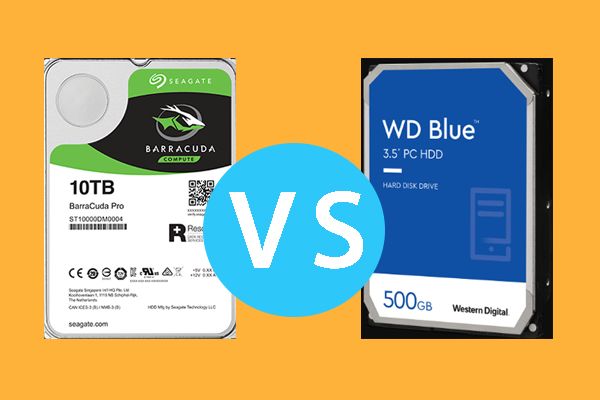When it comes to choosing between Western Digital (WD) and Seagate hard drives, there are a few key differences to consider. Both WD and Seagate are popular brands that make reliable drives, so it really comes down to your specific needs and preferences.
Reliability
One of the most important factors for any hard drive is reliability. You want to choose a drive that can safely store your important files and data over time. Overall, WD and Seagate hard drives have similar reliability ratings from independent testing organizations like Backblaze. However, there are some differences:
- WD drives tend to have slightly lower failure rates according to Backblaze’s stats. For example, over a recent 4 year period, WD drives had an average annual failure rate of 1.7% compared to Seagate’s 2.2%.
- Seagate’s Barracuda line has higher than average failure rates according to Backblaze, while their Enterprise and IronWolf NAS drives perform better.
- WD’s lower-end Blue drives tend to be less reliable than their higher-end Black and Red drives according to Backblaze’s findings.
So when it comes to reliability, WD edges out Seagate overall, but Seagate still makes many reliable drive models. As long as you avoid Seagate’s budget Barracuda line, both brands offer comparable dependability.
Performance
Performance is another key consideration when shopping for a hard drive. Faster drives allow you to boot your system, launch apps, transfer files, and manage data more quickly. Here’s how WD and Seagate compare when it comes to performance:
- WD’s Black line is optimized for performance with features like dual-core CPUs. Benchmarks show WD Black drives consistently outperforming Seagate’s fastest drives.
- Seagate’s Barracuda drives offer decent performance for everyday computing at a budget-friendly price point.
- Both brands offer speedy SSD options, but reviewers tend to favor WD’s SSDs over Seagate’s when it comes to sustained performance.
- For RAID setups, WD’s Red Pro drives excel, while Seagate’s IronWolf and Enterprise drives also offer great performance.
Overall, WD tends to have a performance edge, especially in their high-end Black line. But Seagate still offers competitive performance in many drive models.
Features
WD and Seagate drives also differ in some of their special features:
- WD’s Red drives are specifically designed for NAS and RAID environments. They include features like vibration protection and error recovery control for optimal performance in those setups.
- Seagate’s IronWolf drives are similarly built for NAS systems, with features like AgileArray and rotational vibration sensors to reduce vibrations in multi-drive environments.
- Both brands offer secure, encrypted drives using AES hardware encryption. But Seagate’s IronWolf Pro drives offer an extra layer of security by supporting CSI standards.
- WD drives tend to have marginally longer warranties. Many Seagate drives have 2-3 year warranties, while many WD drives have 3-5 years.
So when it comes to special features, both brands tailor drives for NAS, RAID, and other specific use cases. They’re fairly evenly matched overall.
Price
Pricing often helps makes the final call between two similar products. Here’s an overview of how WD and Seagate hard drives compare when it comes to price:
- Seagate’s budget Barracuda line is highly affordable, with drives starting under $50 for 1TB models. WD’s cheapest Blue drives still cost around $10-20 more.
- For mid-range consumer drives, WD edges out Seagate when it comes to value. Models like the 4TB WD Blue offer better performance than Seagate Barracudas for just a bit more money.
- In the high-performance tier, WD Black drives outpace Seagate’s comparably priced FireCuda models. However, Seagate’s higher-end Enterprise drives compete well with WD Blacks on both price and performance.
- For NAS-optimized drives, WD Reds tend to cost $5-20 less than comparable Seagate IronWolf models.
Across most tiers, Western Digital hard drives generally have a slight price advantage over Seagate. But Seagate’s budget drives give them the lowest entry point.
Compatibility
WD and Seagate drives have broadly similar compatibility with modern PCs, Macs, gaming consoles, RAID systems, NAS devices, and other storage environments. A few compatibility differences include:
- Seagate makes Xbox-specific Game Drives that are optimized and tested for the Xbox One and Xbox Series X/S. WD drives will work with Xbox too, but aren’t tailored for it.
- WD’s drives are better optimized out of the box for Synology NAS devices. But Seagate drives can work just as well once configured properly.
- Seagate’s storage monitoring software (SeaTools) only works with Seagate drives. WD’s equivalent software supports WD drives only.
When it comes to OS, interface, and general hardware compatibility, both WD and Seagate support all the latest standards. They’ll both work seamlessly with modern computers without any major compatibility issues.
Conclusion
When choosing between WD vs Seagate hard drives, Western Digital wins out in a few key categories:
- WD drives are a bit more reliable according to failure rate data.
- WD products generally perform better, especially their high-end Black line.
- WD drives tend to have slightly lower prices across most tiers.
However, Seagate still makes excellent hard drives. Their budget drives offer unbeatable value. And their Enterprise and NAS-optimized IronWolf models compete well with WD’s offerings. Seagate drives also have a niche advantage for Xbox compatibility.
For most home and office uses, WD is the better brand to go with. But you can’t go wrong with Seagate either. At the end of the day, both companies make high-quality drives that can safely store your data for years.
